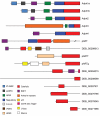The role of ADP-ribosylation in regulating DNA double-strand break repair
- PMID: 22186780
- PMCID: PMC3272231
- DOI: 10.4161/cc.11.1.18793
The role of ADP-ribosylation in regulating DNA double-strand break repair
Abstract
ADP-ribosylation is the post translational modification of proteins catalysed by ADP-ribosyltransferases (ARTs). ADP-ribosylation has been implicated in a wide variety of cellular processes including cell growth and differentiation, apoptosis and transcriptional regulation. Perhaps the best characterised role, however, is in DNA repair and genome stability where ADP-ribosylation promotes resolution of DNA single strand breaks. Although ADP-ribosylation also occurs at DNA double strand breaks (DSBs), which ARTs catalyse this reaction and the molecular basis of how this modification regulates their repair remains a matter of debate. Here we review recent advances in our understanding of how ADP-ribosylation regulates DSB repair. Specifically, we highlight studies using the genetic model organism Dictyostelium, in addition to vertebrate cells that identify a third ART that accelerates DSB repair by non-homologous end-joining through promoting the interaction of repair factors with DNA lesions. The implications of these data with regards to how ADP-ribosylation regulates DNA repair and genome stability are discussed.
Figures

References
-
- Caldecott KW. Single-strand break repair and genetic disease. Nat Rev Genet. 2008;9:619–631. - PubMed
Publication types
MeSH terms
Substances
Grants and funding
LinkOut - more resources
Full Text Sources
Miscellaneous
